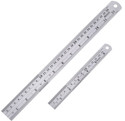We Are Not Calibrating!
- Heather Wade

- Jan 25, 2022
- 3 min read
Updated: Apr 12, 2024
"But we aren't calibrating because we aren't making any adjustments!"
If I had a dollar for every time I've heard this statement, I could retire. But I can't retire because there is a lot of work to do to help folks improve their measurements and their measurement knowledge.
THEN WHAT IS CALIBRATION???

Let's begin by looking at the International Vocabulary of Metrology (VIM) definition of calibration.
VIM: Calibration is an "operation that, under specified conditions, in a first step, establishes a relation between the quantity values with measurement uncertainties provided by measurement standards and corresponding indications with associated measurement uncertainties and, in a second step, uses this information to establish a relation for obtaining a measurement result from an indication.
NOTE 2: Calibration should not be confused with adjustment of a measurement system nor with the verification of calibration."[1]
Simply put, calibration is a COMPARISON.
A comparison between a known measurement standard's measurement value, with measurement uncertainty, and an unknown in order to obtain a measurement result for the unknown (also with measurement uncertainty).
Calibration is NOT adjustment.
Calibration process may include adjustment, but not all measurement instruments can be adjusted. Think of the measurement instruments below: steel rulers, protractor, liquid-in-glass thermometer.
None of these measurement instruments can be adjusted, but they CAN be calibrated;
they CAN be compared to more accurate reference standards.
So, what does this mean for the folks who are doing these comparisons and not adjusting the measurement instruments? Whether the measuring instruments can be adjusted or not, if one is performing the steps of a "calibration", including calculating measurement uncertainty, then one IS calibrating.
Furthermore, as stated in the VIM definition of calibration, Note 2, calibration should not be confused with verification (of calibration). According to the VIM, verification is a "provision of objective evidence that a given item fulfils specified requirements."[2]
Verification is often considered a quality check; is my measuring instrument still working properly and making 'accurate' measurements? Verification may often be performed as an abbreviated version of a calibration process where only a few parameters or ranges of a measurement instrument are checked. Typically, measurement uncertainty is not calculated in a verification (although it can be!).
Whether you are performing calibration or verification, one thing that must be ensured is metrological traceability. Metrological traceability is defined in the VIM as the "property of a measurement result whereby the result can be related to a reference through a documented unbroken chain of calibrations, each contributing to the measurement uncertainty."[3]
Sometimes, these different terms can be confusing, especially when they are so often incorrectly used. If you have further questions about calibration, verification, adjustments, metrological traceability, or anything else, please contact me. Do you or does your company need help reviewing/improving your policies, procedures, and processes? We can help!
Footnote
[1]: JCGM 200:2012 International Vocabulary of Metrology, Basic and general concepts and associated terms (VIM) 3rd edition; Calibration (2.39).
[2]: JCGM 200:2012 International Vocabulary of Metrology, Basic and general concepts and associated terms (VIM) 3rd edition; Verification (2.44).
[3]: JCGM 200:2012 International Vocabulary of Metrology, Basic and general concepts and associated terms (VIM) 3rd edition; Metrological traceability (2.41).
JCGM 200:2012 is the same document as ISO/IEC Guide 99:2007 International Vocabulary of Metrology, Basic and general concepts and associated terms (VIM). Download your free copy of JCGM 200:2012 by signing up here...
JCGM 200:2012 is available for FREE at https://bit.ly/3GLMnxD
JCGM 200:2012 is the same document as ISO/IEC Guide 99:2007 International Vocabulary of Metrology, Basic and general concepts and associated terms (VIM)
ISO/IEC Guide 99:2007 is available for a fee at https://bit.ly/3FPaCK8
(Hint: get the free one!)







Comments